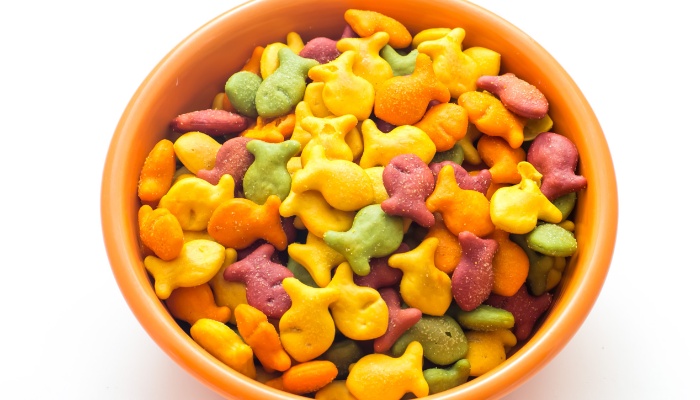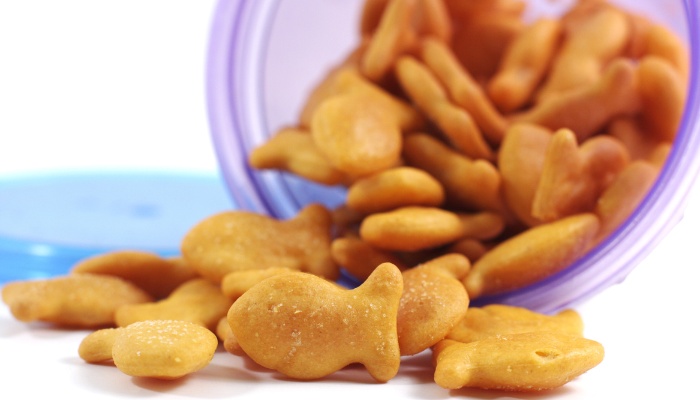It appears that the adorable fish design and delectable cheesy flavor of Goldfish Crackers are specifically crafted for picky children!
With their melt-in-the-mouth quality, they’re probably fine as a baby snack too, right? Not for very young babies. So when is this snack food appropriate for them?
When can babies eat Goldfish? Babies can safely be introduced to Goldfish crackers after the age of 1 when their first molars begin to develop, enabling them to chew properly. Softer snacks are more appropriate before this age as babies may find the crispy texture of crackers painful to bite down on.
The nature of these slightly hard, crispy crackers can also pose a choking risk for little mouths unfamiliar and unpracticed with chewing.
Keep reading to find out when and how you can start to offer your baby this cheesy treat, what to look for in baby crackers in general, healthier snack alternatives, and more.
Goldfish for Babies – What To Know
With their low-sugar and omega-3 content, Goldfish crackers can be a suitable snack for your little one — once they can safely chew their food.
Let’s look at what’s in this cheesy snack food and how safe they are for babies.
Goldfish Cracker Ingredients
A 6.6-ounce bag of Original Goldfish Crackers is high in sodium with 230 mg per serving (55 pieces) and 140 calories per serving.
Full ingredients:
- Wheat flour
- 2-percent nonfat milk
- Vegetable oils
- Salt
- Sugar
- Yeast
- Baking soda
- Paprika
- Spices
- Celery
- Onion powder
Nutrition info:
- Reduced iron (0.7 mg)
- Calcium (20 g)
- Folic Acid (40 mcg)
- Niacin (1.9 mg)
- Thiamin (0.19 mg)
- Folate (80 mcg)
- Riboflavin (0.13 mcg)
Earliest Age To Offer Goldfish to Baby
According to the food introduction guidelines set by the AAP (American Academy of Pediatrics), babies under 12 months cannot safely chew their food, so crunchy processed foods like Goldfish crackers should only be offered beyond the age of 1 year at the earliest.
At this stage, your baby’s molar teeth begin forming, making it easier to handle slightly harder foods as they begin to chew instead of gum.
Are Goldfish a Choking Hazard?
As Goldfish crackers are on the hard, crispy side, there is a risk that small pieces might break off, causing them to choke.
Another risk of feeding babies Goldfish crackers before they can chew is that pieces can break off and expose sharp edges, causing them pain as they gum down on them rather than using teeth to break them down.
Around 7-9 months, babies can begin trying soft finger foods. After 1 year, their ability to chew will be well practiced, and you can introduce crackers with a low choking risk.
If you are concerned about the choking risk with Goldfish crackers, consider specially-made baby teething biscuits instead.
Types of Goldfish Crackers
In addition to the Original Goldfish recipe, there are more than 20 other varieties and special editions of the crackers with added fats, colors, and preservatives. Some of the most popular are:
- Cheddar
- Wholegrain Cheddar (extra protein and fiber)
- Parmesan
- Pizza (containing tomato paste and celery seed)
- Pretzel (high salt, made with beet juice concentrate)
- Baby Cheddar (smaller version of the original)
- Mega Bites (larger pieces in “Sharp Cheddar” and “Cheddar Jalapeno”)
- Flavor Blasted Sour Cream & Onion
- Goldfish Graham’s Vanilla Cupcake
- Goldfish Colors sourced from plants (made with beet and watermelon)
Baby Goldfish Crackers
The “Baby” edition of Goldfish crackers is made with roughly the same ingredients as the original Cheddar recipe but with much smaller Goldfish pieces at around 89 pieces per adult serving.
This variety is slightly higher in sodium with 230 mg per serving and comes in a 7.2-ounce pouch compared to the original 6.6-ounce Goldfish cracker packaging.
Tips for Feeding Goldfish Crackers

If your child has a medical condition or food allergy of any kind, be sure to “speak with your pediatrician about introducing Goldfish crackers to their diet” urges Mom News Daily.
Otherwise, you can slowly introduce Goldfish crackers as an occasional snack to your little one. Here are a few hints and tips on how to feed them safely:
- Limit servings to a very small handful (about 6-10 pieces)
- Always supervise them closely, and remind them to chew if gagging occurs. Stacia Paganelli, MA – Infant feeding consultant and author of the Help With Feeding blog – notes”
“Gagging is common as children learn to move food around their mouths. Just be there to reassure them and remind them by vocalizing “chew, chew” and model the same mouth movements. The last thing you want to do is teach your baby that new food is scary by pulling them out of their highchair the minute they cough or gag!”
- Place pieces inside your baby’s cheek to encourage chewing and biting down
- Try offering cracker crumbs to begin with. Paganelli recommends “dipping their teether in a favorite puree and coating it with cracker crumbs.” Place the teether on their side gums to help encourage chewing and reduce gagging.
Best Crackers for Babies
Baby-appropriate crackers should have a soft and easy-to-gum texture as your 1-year-old will still be in the early teething stages. Nothing too hard, too crunchy, or with a bumpy texture such as foods covered in seeds or nuts.
You should also opt for low-sodium crackers wherever possible as babies will get their daily sodium intake elsewhere in breast milk, formula, and finger foods.
Lastly, be careful with wholegrain crackers. While the added fiber is great for your little one, crackers with a noticeable high-fiber content may be too hard and texturized for them to chew.
Best Cracker Brands for Babies
- Baby Rice Rusks (bland but great teething material)
- Breton (soft crackers in a wide range of grains and flavors)
- Ritz (soft and easy to gum)
- Happy Family Organics (makers of great teething crackers)
Healthy Snacks for Babies and Toddlers
Crackers may be convenient to reach for, but there are plenty of tasty (and far healthier), quick, and easy snacks for your little one. Here are some great snacking options from 7 months into toddlerhood!
Snacks for Babies 7 Months
Now they’re getting to the age that they can pick up foods, give them foods like:
- Pieces of soft cheese
- Bite-sized pieces of soft bread and pasta
- Finely chopped soft fruit varieties such as banana, pear, and ripe peaches
- Finely chopped, soft, and well-cooked vegetables like broccoli, cauliflower, and carrot
Snacks for Babies 9-12 Months
You can introduce more food groups in their snacks for balance. Include a mix of foods like:
- Yogurt or cottage cheese with small fruit pieces
- A mix of steamed veggies and finely chopped fruit chunks
- Thinly spread almond or peanut butter on small pieces of toast
- Bite-sized pieces of hard-boiled egg
- Low-sodium slices of chicken/ham/turkey
- Teething biscuits and soft crackers
Healthy Snack Ideas for Toddlers
- Cooked carrots, red peppers, or cucumber cut into sticks and served with a favorite savory dip or puree
- Wholegrain toast slices, small tortillas, or breadsticks paired with a hummus or nut butter dip
- Minimally processed deli meats with wholegrain bread or hard-boiled egg slices/chunks
- Smoothies made with yogurt or milk
- Nutritious energy balls like these
- Chopped walnuts/pecans/cashews
- Fruit yogurts with a wholegrain muffin cut into quarters
Related Questions:
How Many Goldfish Flavors Are There?
As of May 2022, there are over 25 varieties of Goldfish cracker flavors ranging from wholegrain, pretzel, and plant-based crackers to stronger-flavored varieties such as pizza, parmesan, and vanilla cupcake Goldfish.
Can Babies Eat Saltine Crackers?
Saltine crackers are fine to feed your baby in moderation, but try to opt for low-sodium varieties with plain (unsalted and unseasoned) tops.
Babies already get the salt they need from breast milk or formula for the first 6 months and from formula and subsequent baby food after that.
Conclusion
To sum up, the American Academy of Pediatrics advises that Goldfish crackers and similar crispy, crunchy snack foods should not be given to children under 1 year old.
After the age of 12 months, babies develop the ability to chew their food, and the appearance of their back molar teeth ensures these harder food types are broken down more easily.
As with introducing any new food type, do so slowly, and speak with your doctor if you have concerns involving food allergies and feeding issues with your little one.
Mom of three (including identical twin boys), wife, and owner of Parents Wonder. This is my place to share my journey as a mother and the helpful insights I learn along the way.

